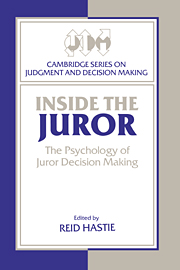Book contents
- Frontmatter
- Contents
- Series preface
- List of contributors
- Editor's preface
- Acknowledgments
- Part I Models of juror decision making
- 1 Introduction
- 2 Some steps between attitudes and verdicts
- 3 The influence of outcome information and attitudes on juror decision making in search and seizure cases
- 4 Algebraic models of juror decision processes
- 5 Stochastic models of juror decision making
- 6 Formal and empirical research on cascaded inference in jurisprudence
- 7 Argument structuring and evidence evaluation
- 8 The story model for juror decision making
- Part II Commentaries
- Index of names
- Index of subjects
7 - Argument structuring and evidence evaluation
Published online by Cambridge University Press: 04 August 2010
- Frontmatter
- Contents
- Series preface
- List of contributors
- Editor's preface
- Acknowledgments
- Part I Models of juror decision making
- 1 Introduction
- 2 Some steps between attitudes and verdicts
- 3 The influence of outcome information and attitudes on juror decision making in search and seizure cases
- 4 Algebraic models of juror decision processes
- 5 Stochastic models of juror decision making
- 6 Formal and empirical research on cascaded inference in jurisprudence
- 7 Argument structuring and evidence evaluation
- 8 The story model for juror decision making
- Part II Commentaries
- Index of names
- Index of subjects
Summary
Summary
I have often wondered how many of the subtleties in evidence presented at trial are actually recognized by factfinders and then incorporated in their conclusions. William Twining (1984) goes even farther in wondering how skillful are advocates themselves in recognizing evidentiary subtleties and then in explaining their significance to factfinders. One thing certain is that skillful advocates do not usually offer evidence haphazardly at trial but according to some design or strategy, the objective in such strategies being the presentation of what advocates judge to be the best possible argument on behalf of their clients. It seems likely that, in most cases, advocates spend a significant amount of time before trial in structuring the arguments they will offer. Under the best of conditions, this is not an easy task; given a large mass of evidence it may well be an overwhelming task. That different arguments are possible from the same evidence is one reason why there is to be a trial in the first place. One thing an advocate can be assured of is that his/her arguments will be carefully decomposed or dissected by the opposing advocate. Several current works acknowledge the importance of careful argument structuring by advocates during pretrial preparations and offer various forms of assistance to this process (Anderson & Twining, 1991; Binder & Bergman, 1984).
- Type
- Chapter
- Information
- Inside the JurorThe Psychology of Juror Decision Making, pp. 175 - 191Publisher: Cambridge University PressPrint publication year: 1993
- 14
- Cited by

